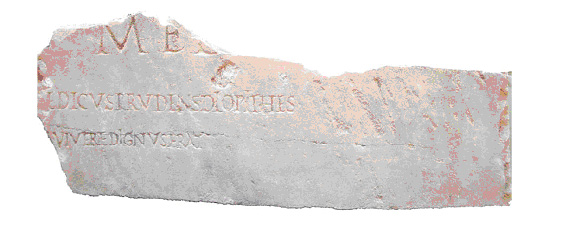Epitaph of the doctor Diopithes
Reference AE 2009, 00570 | Description | Lyrics | Location | Chronology | Epigraphic edition | Translation | Apparatus | Comentary | Type of verse | Text divided into verses and metric signs | Images | Bibliography | Link to DB | Author |
Epitaph of the doctor Diopithes
Description
- Idno filename 22/01/0063
- Type of inscription: Sepulcralis
- Support: Placa
- Material: Mármol Material Description: Fragment of a funerary tablet of rectangular white marble
- Conservation status: Lower right fragment with damaged edges except at the base and scratching on the surface. The back surface is smooth.
- Dimensions height/width/depth (cm): 48.5/17.4/3.8
- Conservada
Lyrics
- Font:Capital con tendencia a libraria
- Letter size:4,1 and 1,8 cm
- Description of the letters:Letter height 4.1, square capitals in l. 1 corresponding to prose praescriptum, and 1.8 tending to book script in the carmen in ll. 2 and 3. The left stroke of the <A> intersects in the middle of the writing box with the right stroke, which spills over the writing box; the horizontal stroke of the <T> curves upwards; the vertical appendix of the <G> is finished off with a long horizontal stroke towards the left; the lower stroke of the <I> is longer than the upper one; three <I> longae in Diopithes and in dignus, corresponding respectively to a short vowel (although in Greek it can also be represented with the diphthong), a long vowel and a short vowel in a long syllable.
Location
- Place of discovery: It was found in Cádiz, in a grave next to which there was another fragment of a tombstone, dedicated to another doctor (P. Fabius / Sergia / Athenodorus / medicus), and alongside some one hundred other graves, in the course of an urgent archeological dig carried out at the site of the Ciudad de la Justicia by F. SIBÓN OLANO, F. BLANCO and others in 2004-2005.
- Geolocation
- Conservation location: It is preserved in the store of the Museo de Cádiz.
- Inventory number: 28758
- Location with Modern Nomenclature España / Cádiz
- Location with Old Nomenclature Hispania / Baetica / Gaditanus / Gades
Chronology
- Inscription's dating: Between year 170 and year 230
- Dating explanation: End of 2nd c. or 3rd c. from the paleography.
Type of verse
- Type of verse: Dactílico (dístico elegíaco)
- Verse/line correspondence: Si
- Prose/verse distinction: Si
Epigraphic edition
[‑ ‑ ‑ ‑ ‑ ‑]
med(icus)
[‑ ‑ ‑ m]edicus prudens ▴Diopithes ▴
[…]+ ▴ vivere dignus erat
Text divided into verses and metric signs
(m)edicus prudens Diopithes [qnq nq]
vivere dignus erat [qnq nq]
Translation
“[---] doctor. The prudent doctor Diopithes,[---] deserved to live”
Bibliography
Ruiz Castellanos 2009, 319–321.
Apparatus
3 [aevu]m ante vivere coniecit RUIZ CASTELLANOS.-
Comentary
The lines of the praescriptum were probably centered on the stone, while the verses would have begun in the left margin, to judge by the relative position of both and their relation to the right margin preserved, as well as by analogy with the perfectly centered layout of the inscription to Athenodorus together with which it appeared and which seems to have been sculpted following the same pattern.
From the elegiac distich of the carmen the second part of the hexameter is conserved from the penthemimeral caesura, and the second hemistich of the pentameter is conserved preceded by a stroke which could correspond to the top right-hand corner of a letter, which Ruiz Castellanos considers to be a <M> but which could also be a <I> <N>, <S> o <T>, or more probably a <A>. The syntagma medicus prudens reflects a virtue ascribed to doctors, which is featured in the proemium of book 1 of De medicina by Cels. (prudentem medicum), in other medical works and in dactylic verses, both in the usual sense of ‘cautious’ and ‘expert’ and in the etymological sense of ‘foreseeing’. Ovid, for his part, had used the sequence vivere dignus erat at the beginning of a hexameter (Ov. Met. 10,633), and the second part of the pentameter appears in more recent epitaphs.
As in other epitaphs from different eras, the beginning of the hexameter could have contained a burial formula such as iacet in hoc tumulo or the like, and the pentameter a relative clause introduced by qui, and ending with a causal complement in the dative (qui sibi, quique aliis) or more probably with a time adverb (qui tamen aeternum; vir qui perpetuum), or with a substantive referring to a space of time (vitam, aevum, saecula, annos) in the accusative (qui Pylios aevum; saecula qui centum…).
The Greek name Diopithes (Διoπείθης) is best known with reference to the famous Athenian general defended by Demosthenes, although in Latin it only appears as a variant of other names in some codices (cf. ThLL, Onom.3,180, 75-82) and in at least another three prose inscriptions in Rome noted by Solin (1982, p. 43).
Author
- Author:J. Pascual Barea
- Last Update2023-11-21 13:48:55
You can download this




